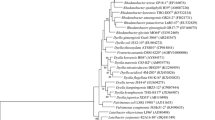Abstract
A Gram-negative, straight rod and facultative anaerobic bacterium was isolated from soil sample. It exhibits the phenotypic characteristics consistent with its classification in the genus Enterobacter. The isolate ferment glucose to acid and gas. Arginine dihydrolase, ornithin decarboxylase and gelatinase but not deoxyribonuclease was produced by this isolate. There was no hydrogen sulfide production. On the basis of the phenotypic data, together with phylogenetic analysis based on 16S rDNA gene sequences, this strain should represent a novel species of the genus Enterobacter and was designated as LB37. The strain LB37 could degrade xanthan molecules resulting in the rapid decrease of the viscosity of xanthan solution used in oil drilling process. Endoxanthanase activity was also detected in the culture supernatant. To our knowledge, it is the first report on the microbes being involved in the xanthan degradation for oil industry. The isolate LB37 would be useful for potential application in enhanced oil recovery and oil drilling field.




Similar content being viewed by others
References
Ahlgren JA (1993) Purification and properties of a xanthan depolymerase from a heat-stable salt-tolerant bacterial consortium. J Ind Microbiol 12:87–92
Altschul SF, Madden TL, Schäffer AA, Zhang J, Zhang Z, Miller W, Lipman DJ (1997) Gapped BLAST and PSI-BLAST: a new generation of protein database search programs. Nucleic Acids Res 25:3389–3402
Brenner DJ (1984) Enterobacteriaceae. In: Krieg NR, Holt JG (eds) Bergey’s manual of systematic bacteriology. Williams and Wilking, Baltimore, pp 408–516
Brenner DJ, Richard C, Steigerwalt AG, Asbury MA, Mandel M (1980) Enterobacter gergoviae sp. nov.: a new species of Enterobacteriaceae found in clinical specimens and the environment. Int J Syst Bacteriol 30:1–6
Brenner DJ, McWhorter AC, Kai A, Steigerwalt AG, Farmer JJ III (1986) Enterobacter asburiae sp. nov., a new species found in clinical specimens, and reassignment of Erwinia dissolvens and Erwinia nimipressuralis to the genus Enterobacter as Enterobacter dissolvens comb. nov. and Enterobacter nimipressuralis comb. nov. J Clin Microbiol 23:1114–1120
Cadmus MC, Jackson LK, Burton KA, Platiner RD, Slodki ME (1982) Biodegradation of xanthan gum by Bacillus sp. Appl Environ Microb 44:5–11
Cole JR, Chai B, Farris RJ, Wang Q, Kulam SA, McGarrell DM, Garrity GM, Tiedje JM (2005) The ribosomal database project (RDP-II): sequences and tools for high-throughput rRNA analysis. Nucleic Acids Res 33:294–296
Dickey RS, Zumoff CH (1988) Emended description of Enterobacter cancerogenus comb. nov. (formerly Erwinia cancerogena). Int J Syst Bacteriol 38:371–374
Edwards PR, Ewing WH (1972) Identification of Enterobacteriaceae, 3rd edn. Burgess Publishing Co., Minneapolis
Felsenstein J (2005) PHYLIP (Phylogeny Inference Package) version 3.6. Distributed by the author, Department of Genome Sciences, University of Washington
Fox GE, Wisotzkey JD, Jurtshuk P (1992) How close is close: 16S rRNA sequence identity may not be sufficient to guarantee species identity. Int J Syst Bacteriol 42:166–170
Garcia-Ochoa F, Santos VE, Casas JA, Gomez E (2000) Xanthan gum: production, recovery, and properties. Biotechnol Adv 18:549–579
Hashimoto W, Miki H, Tsuchiya N, Nankai H, Murata K (1998) Xanthan lyase of Bacillus sp. strain GL1 liberates pyruvylated mannose from xanthan side chains. Appl Environ Microb 64:3765–3768
Hoffmann H, Stindl S, Stumpf A, Mehlen A, Monget D, Heesemann J, Schleifer KH, Roggenkamp A (2005a) Description of Enterobacter ludwigii sp. nov., a novel Enterobacter species of clinical relevance. Syst Appl Microbiol 28:206–212
Hoffmann H, Stindl S, Ludwig W, Stumpf A, Mehlen A, Heesemann J, Monget D, Schleifer KH, Roggenkamp A (2005b) Reassignment of Enterobacter dissolvens to Enterobacter cloacae as E. cloacae subspecies dissolvens comb. nov. and emended description of Enterobacter asburiae and Enterobacter kobei. Syst Appl Microbiol 28:196–205
Hou CT, Barnabe N, Greaney K (1986) Purification and properties of a novel xanthan depolymerase from salt-tolerant bacterial culture, HD1. Appl Environ Microb 52:37–44
Kosako Y, Tamura K, Sakazaki R, Miki K (1996) Enterobacter kobei sp. nov., a new species of the family Enterobacteriaceae resembling Enterobacter cloacae. Curr Microbiol 33:261–265
Li B, Guo J, Chen W, Chen X, Chen L, Liu Z, Li X (2009) Endoxanthanase, a novel β-d-glucanase hydrolyzing backbone linkage of intact xanthan from newly isolated Microbacterium sp. XT11. Appl Biochem Biotech 159:24–32
Liu H, Huang C, Dong W, Du Y, Bai X, Li X (2005) Biodegradation of xanthan by newly isolated Cellulomonas sp. LX, releasing elicitor-active xantho-oligosaccharides-induced phytoalexin synthesis in soybean cotyledons. Process Biochem 40:3701–3706
Murray RGE, Doetsch RN, Robinow CF (1994) Determinative and cytological light microscopy. In: Gerhardt P, Murray RGE, Wood WA, Krieg NR (eds) Methods for general and molecular bacteriology. American Society for Microbiology, Washington DC, pp 21–41
Nankai H, Hashimoto W, Miki H, Kawai S, Murata K (1999) Microbial system for polysaccharide depolymerization: enzymatic route for xanthan depolymerization by Bacillus sp. strain GL1. Appl Environ Microb 65:2520–2526
O’hara CM, Steigerwalt AG, Hill BC, Farmer JJ III, Fanning GR, Brenner DJ (1989) Enterobacter hormaechei, a new species of the family Enterobacteriaceae sormerly known as Enteric Group 75. J Clin Microbiol 27:2046–2049
Qian F, An L, Wang M, Li C, Li X (2007) Isolation and characterization of a xanthan-degrading Microbacterium sp. strain XT11 from garden soil. J Appl Microbiol 102:1362–1371
Richard C (1984) Genus VI Enterobacter. In: Krieg NR, Holt JG (eds) Bergey’s manual of systematic bacteriology. Williams and Wilking, Baltimore, pp 465–469
Ruijssenaars HJ, De Bont JAM, Hartmans S (1999) A pyruvated mannose-specific xanthan lyase involved in xanthan degradation by Paenibacillus alginolyticus XL-1. Appl Environ Microb 65:2446–2452
Ruijssenaars HJ, Hartmans S, Verdoes JC (2000) A novel gene encoding xanthan lyase of Paenibacillus alginolyticus strain XL-1. Appl Environ Microb 66:3945–3950
Sandford PA, Pittsley JE, Knutson CA, Watson PR, Cadmus MC, Jeanes A (1977) Variation in Xanthomonas campestris NRRL B 1459: characterization of xanthan products of differing pyruvic acid content. ACS Symp Ser 45:192–210
Smibert RM, Krieg NR (1994) Phenotypic characterization. In: Gerhardt P, Murray RGE, Wood WA, Krieg NR (eds) Methods for general and molecular bacteriology. American Society for Microbiology, Washington DC, pp 607–654
Sutherland IW (1982) An enzyme system hydrolyzing the polysaccharides of Xanthomonas species. J Appl Microbiol 53:385–393
Thompson JD, Gibson TJ, Plewniak F, Jeanmougin F, Higgins DG (1997) The CLUSTAL_X windows interface: flexible strategies for multiple sequence alignment aided by quality analysis tools. Nucleic Acids Res 25:4876–4882
Van Hamme JD, Singh A, Ward OP (2003) Recent advances in petroleum microbiology. Microbiol Mol Biol Rev 67:503–549
Wagner-Döbler I, Rheims H, Felske A, El-Ghezal A, Flade-Schröder D, Laatsch H, Lang S, Pukall R, Tindall BJ (2004) Oceanibulbus indolifex gen. nov., sp. nov., a North Sea alphaproteobacterium that produces bioactive metabolites. Int J Syst Evol Micrbiol 54:1177–1184
Wiik R, Stackebrandt E, Valle O, Daae FL, RØdesth ODDM, Andersen K (1995) Classification of fish-pathogenic Vibrios based on comparative 16S rRNA analysis. Int J Syst Bacteriol 45:421–428
Acknowledgments
We are grateful for support from National Natural Science Foundation of China (31371742), Program for Liaoning Innovative Research Team in University (LT2011008), Special Fund for Agroscientific Research in the Public Interest (201303095), Science and technology Department of Liaoning and Dalian (2009402009, 2010415011, 2013B11NC078).
Author information
Authors and Affiliations
Corresponding author
Rights and permissions
About this article
Cite this article
Chen, X., Wang, M., Yang, F. et al. Isolation and characterization of xanthan-degrading Enterobacter sp. nov. LB37 for reducing the viscosity of xanthan in petroleum industry. World J Microbiol Biotechnol 30, 1549–1557 (2014). https://doi.org/10.1007/s11274-013-1578-8
Received:
Accepted:
Published:
Issue Date:
DOI: https://doi.org/10.1007/s11274-013-1578-8




